Executive Summary
This research brief analyzes multiple data sources to provide a demographic portrait of LGBT parenting in the United States. Main findings from the report include: An estimated 37% of LGBT-identified adults have had a child at some time in their lives.
- An estimated 37% of LGBT-identified adults have had a child at some time in their lives.
- An estimated 3 million LGBT Americans have had a child and as many as 6 million American children and adults have an LGBT parent.
- Among those under age 50 who are living alone or with a spouse or partner, nearly half of LGBT women (48%) are raising a child under age 18 along with a fifth of LGBT men (20%).
- More than 125,000 same-sex couple households (19%) include nearly 220,000 children under age 18. More than 111,000 same-sex couples are raising an estimated 170,000 biological, step, or adopted children.
- Same-sex couples who consider themselves to be spouses are more than twice as likely to be raising biological, step, or adopted children when compared to same-sex couples who say that they are unmarried partners (31% versus 14%, respectively).
- Same-sex couples raising children are four times more likely than their different-sex counterparts to be raising an adopted child. An estimated 16,000 same-sex couples are
raising more than 22,000 adopted children in the US.
- Same-sex couples are six times more likely than their different-sex counterparts to be raising foster children. Approximately 2,600 same-sex couples are raising an estimated 3,400 foster children in the US.
- More than a quarter of same-sex couples raising children (25.6%) include children identified as grandchildren, siblings, or other children who are related or unrelated to one of the spouses or partners. Approximately 32,000
- Same-sex couple parents and their children are more likely to be racial and ethnic minorities.
- An estimated 39% of individuals in same-sex couples who have children under age 18 in the home are people of color, compared to 36% of those in different-sex couples who are non-White.
- Among children under 18 living with same-sex couples, half (50%) are non-White compared to 41% of children living with different-sex couples.
- Childrearing among same-sex couples is most common in Southern, Mountain West, and Midwest regions of the country. States with the highest proportions of same-sex couples raising biological, adopted or step children include Mississippi (26%), Wyoming (25%), Alaska (23%), Idaho (22%), and Montana (22%).
- LGBT individuals and same-sex couples raising children evidence some economic disadvantage.
- Single LGBT adults raising children are three times more likely than comparable non-LGBT individuals to report household incomes near the poverty threshold.
- Married or partnered LGBT individuals living in two-adult households with children are twice as likely as comparable non-LGBT individuals to report household incomes near the poverty threshold.
- The median annual household income of same-sex couples with children under age 18 in the home is lower than comparable different-sex couples ($63,900 versus $74,000, respectively).
Introduction
This research brief offers analyses from several data sources to provide a demographic portrait of lesbian, gay, bisexual and transgender (LGBT) parenting in the United States. Data sources include the 2008/2010 General Social Survey, the Gallup Daily Tracking Survey, Census 2010, and the Census Bureau’s 2011 American Community Survey (ACS). Details on the data sources are provided in the Methodology section.
How many LGBT people have ever had a child?
Analyses of the 2008/2010 General Social Survey (GSS) estimate that 37% of lesbian, gay, or bisexual (LGB) identified individuals have had a child. A similar proportion of transgender respondents (38%) in the National Transgender Discrimination Survey (NTDS) indicated that they were parents.
Census 2010 tabulations find that there are nearly 235 million adults age 18 and older in the US and data from the Gallup Daily Tracking Survey show that an estimated 3.5% of adults in the US self-identify as LGBT. This implies that there are more than 8.2 million LGBT-identified adults in the US. Applying the parenting figures from the GSS and NTDS data implies that an estimated 3 million LGBT individuals have likely had a child (see Figure 1).
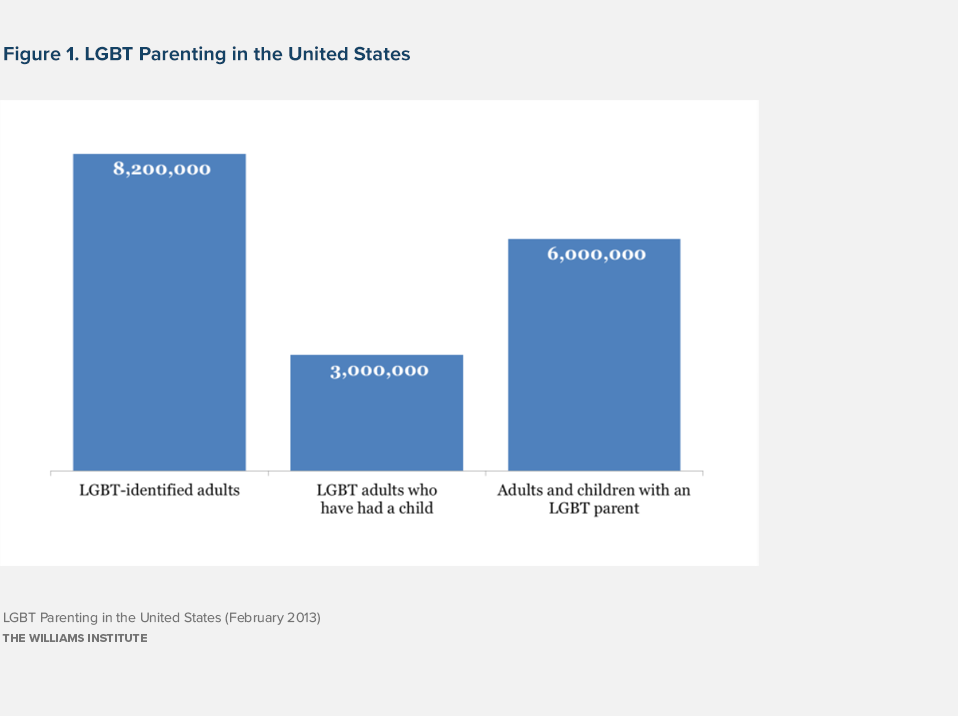
Data Source: Gallup Daily Tracking Survey, June-Sept 2012; General Social Survey 2008-2010; National Transgender Discrimination Survey
The GSS data also show that, on average, LGB individuals who have had children report having two children. If this is also true for transgender individuals, it means that as many as 6 million American children and adults have an LGBT parent. This implies that approximately 2% of Americans have an LGBT-identified parent.
How many LGBT people are parenting young children?
Gallup Daily Tracking Survey data only provide information about the presence of children under 18 in the home instead of actual parenting status. To assess the likelihood of parenting among LGBT and non-LGBT individuals, these next analyses consider comparisons among those most likely to be in a parental role with any children in the household: men and women age 50 or younger who are living alone or with a spouse or partner.
The data show that among this group, 35% are raising a child under age 18. This holds true for nearly half of the LGBT women (48%) in the group and a fifth of the LGBT men (20%). This compares to approximately 70% of comparable non-LGBT men and women (see Figure 2).
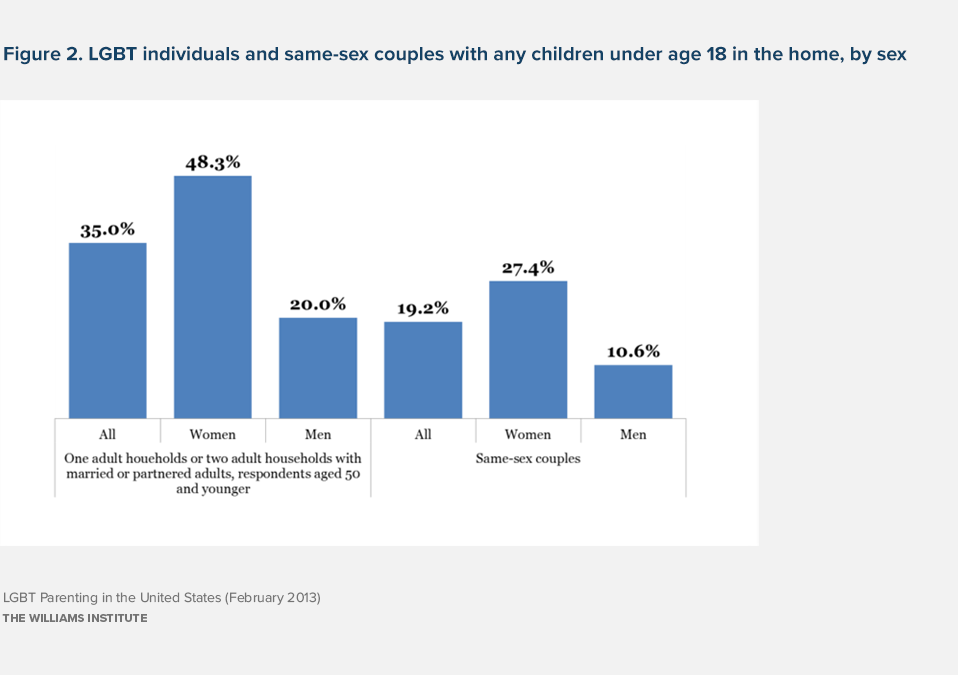
Data Source: Gallup Daily Tracking Survey, June-Sept 2012; 2011 American Community Survey
How many same-sex couples are raising children?
Estimates from Census 2010 suggest that there are nearly 650,000 same-sex couples living in the US. Data from the 2011 ACS show that an estimated 19% of same-sex couple households include children under age 18. This is true for27% of female couples and nearly 11% of male couples.
On average, same-sex couple households with children under age 18 include 1.75 children. This means that there are approximately 125,000 same-sex couples raising nearly 220,000 children. Approximately 3 in a thousand children (0.3%) in the US are living with a same-sex couple.
Parenting of biological, adopted, and step-children
Among same-sex couples raising children, Census 2010 estimates show that more than 111,000 same-sex couples (17%) are raising nearly 170,000 biological, step, or adopted children. Among female couples, nearly 24% are raising a biological, adopted, or step-child compared to 10% of male couples (see Figure 3).

Census 2010 figures show that same-sex couples who consider themselves to be spouses are more than twice as likely to be raising biological, step, or adopted children when compared to same-sex couples who say that they are unmarried partners. Among the same-sex couples who consider themselves to be spouses, 31% (more than 41,000 couples) are raising biological, step, or adopted children under age 18 compared to 14% (nearly 70,000 couples) of same-sex couples who consider themselves to be unmarried partners (see Figure 3).
Nearly 35% of female spousal couples and 28% of male spousal couples are raising biological, step or adopted children. For unmarried partners, the estimates are 21% and 5%, respectively.
Same-sex couples are more likely than their different-sex counterparts to have children who are not identified as biological or step-children of the spouses or partners. This includes adopted children, foster children, other related children like siblings and grandchildren, and non-related children.
Adopted children
Same-sex couples raising children are four times more likely than their different-sex counterparts to be raising an adopted child. Among couples with children under age 18 in the home, 13% of same-sex couples have an adopted child compared to just 3% of different-sex couples. More than 16,000 same-sex couples are raising an estimated 22,000 adopted children in the US (see Figure 4).
Among all children under age 18 being raised by same-sex couples, approximately one in ten (10%) are adopted, compared to just 2% of children being raised by different-sex couples. In total, 1.4% of all adopted children under age 18 living in households with same-sex or different-sex couples live in a same-sex couple household.
Parenting of foster and other children
Same-sex couples are six times more likely than their different-sex counterparts to be raising foster children. Among couples with children under age 18, 2% of same-sex couples are raising a foster child compared to just 0.3% of different-sex couples. Approximately 2,600 same-sex couples are raising an estimated 3,400 foster children in the US. In total, 1.7% of foster children living with same-sex or different-sex couples are being raised by same-sex couples.
More than a quarter of same-sex couples raising children (25.6%) include children identified as grandchildren, siblings, or other children who are related or unrelated to one of the spouses or partners. Approximately 32,000 same-sex couple households include more than 48,000 such children. Among these children living with couples, 0.8% live with a same-sex couple.
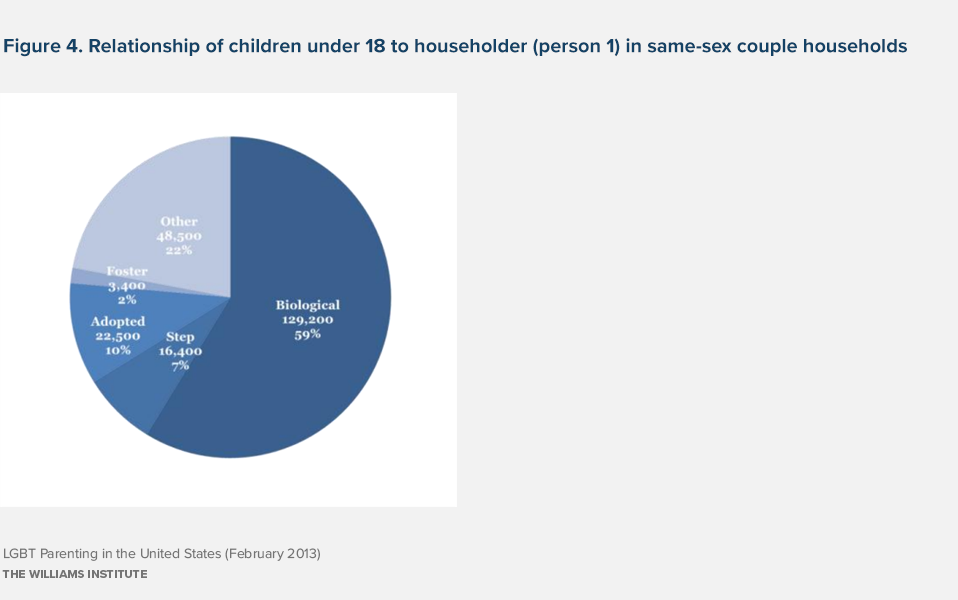
Data Source: American Community Survey
Demographic characteristics of LGBT parents and their children
Sex
Among LGB-identified adults in the GSS who report ever having given birth to or fathered a child, 80% are female, compared to 57% of their heterosexual counterparts.
In the Gallup data, among single LGBT individuals or those who are partnered or married and living in a two-adult household, women comprise 72% of those raising children compared to 55% of comparable non-LGBT individuals.
Among same-sex couples with children under age 18 in the home identified in the 2011 ACS, 61% are female couples.
Age
LGB-identified individuals who report ever having a child in the GSS data indicate that they had their first child at a younger age than their heterosexual counterparts. The median age at which LGB individuals had their first children is 21 compared to 23 for heterosexual individuals.
Among individuals in couples, the median age for those with children under age 18 in the home is 40 for both same-sex and different-sex couples. However, same-sex adoptive parents are younger than their different-sex counterparts by about 2 years. The median age of same-sex adoptive parents is 42 versus 44 for comparable different-sex parents.
Children under 18 being raised by same-sex couples are slightly older than those being raised by different-sex couples. The median age of children under age 18 living with same-sex couples is 9 compared to 8 for those living with different-sex couples. However, adopted children living with same-sex couples are younger. They report a median age of 6 compared to a median age of 10 among adopted children living with different-sex couples.
Race/ethnicity
Parenting is more prevalent among racial and ethnic minorities who are part of a same-sex couple. An estimated 41% of non-White women in same-sex couples have children under age 18 in the home as do 20% of comparable non-White men. Among their White counterparts, the comparable figures are 23% and 8%, respectively.
Among non-White individuals in same-sex couples, a third (33%) is raising a biological, step, or adopted child, compared to 18% of their White counterparts. For men, the same comparison is 16% versus 5%, respectively.
An estimated 39% of individuals in same-sex couples who have children under age 18 in the home are non-White, compared to 36% of individuals in different-sex couples.
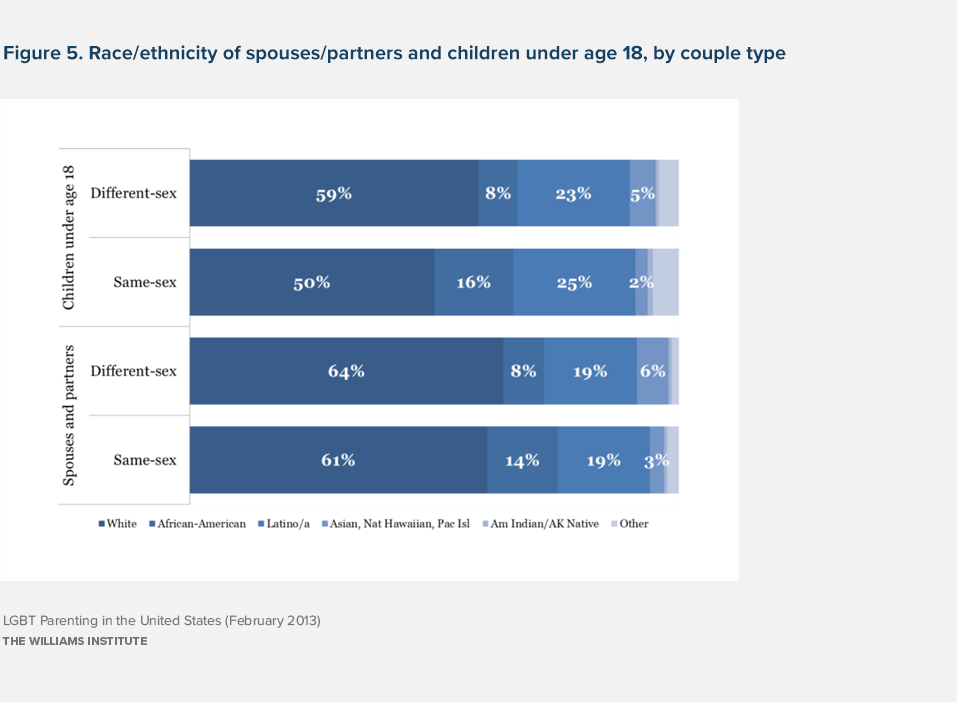
Data Source: 2011 American Community Survey
Among children under 18 living with same-sex couples, half (50%) are non-White compared to 41% of children living with different-sex couples.
Geographic Distribution
Childrearing among same-sex couples is highest in the South, Mountain West, and Midwest areas of the country. (see Figure 6).
States with the highest proportions of same-sex couples raising biological, adopted or stepchildren include Mississippi (26%), Wyoming (25%), Alaska (23%), Idaho (22%), Montana (22%), Kansas (22%), North Dakota (22%), Arkansas (21%), South Dakota (21%), and Oklahoma (21%).
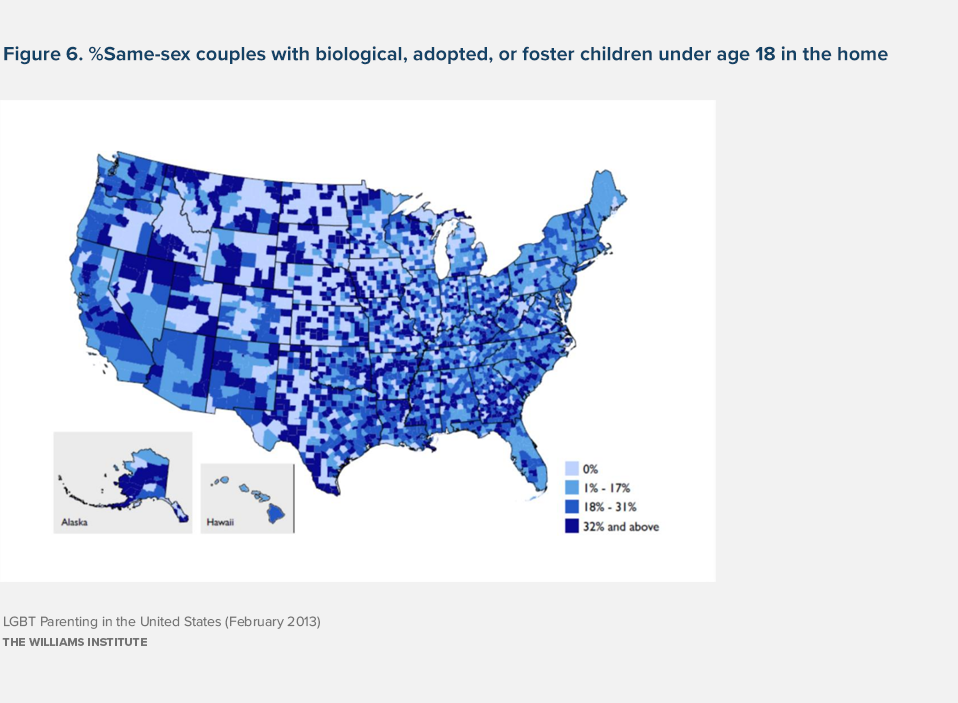
Socioeconomic Status
There is evidence of some economic disadvantage among LGBT people and same-sex couples raising children. This is perhaps not surprising given that LGBT parents and those in same-sex couples are more likely to have characteristics associated with a greater likelihood of being in poverty. For example, LGBT parents and those in same-sex couples are more likely to be female, tend to be younger, and are more likely to be racial/ethnic minorities when compared to non-LGBT people or those in different-sex couples.
Analyses of the Gallup data show that single LGBT adults raising children are three times more likely than comparable non-LGBT individuals to report household incomes near the poverty threshold (less than $12,000 per year). Married or partnered LGBT individuals living in two-adult households with children are twice as likely as comparable non-LGBT individuals to report household incomes near the poverty threshold (less than $24,000 per year).
The median annual household income of same-sex couples with children under age 18 in the home is lower than comparable different-sex couples ($63,900 versus $74,000, respectively).
Among couples with biological, step, and adopted children, the difference is slightly larger, with same-sex couples reporting median annual household income of $63,500 versus $74,900 for different-sex couples.
Other factors that could affect the economic circumstances of same-sex couples with children are employment and labor force participation. While 81% of individuals in both same-sex and different-sex couples with children under age 18 in the home indicate that they are in the labor force, those in same-sex couples are less likely to be employed (72% versus 76% of those in comparable different-sex couples).
Among couples with children, same-sex and different-sex couples are just as likely to have both spouses or partners employed (56%), but same-sex couples are more likely to have neither partner employed (14% versus 5% for different-sex couples). One spouse or partner is employed while the other is not among 31% of same-sex couples with children compared to 38% of comparable different-sex couples.
Download the full brief





